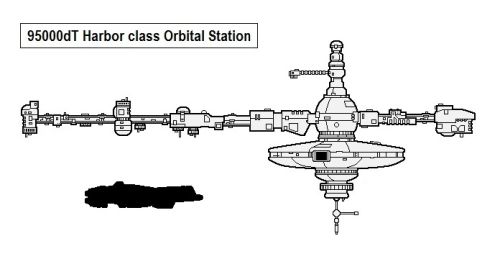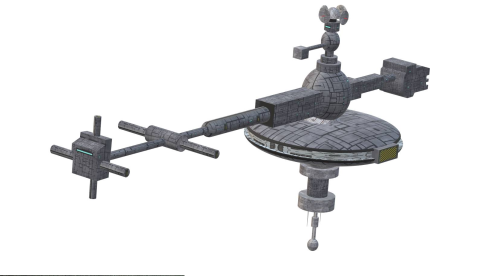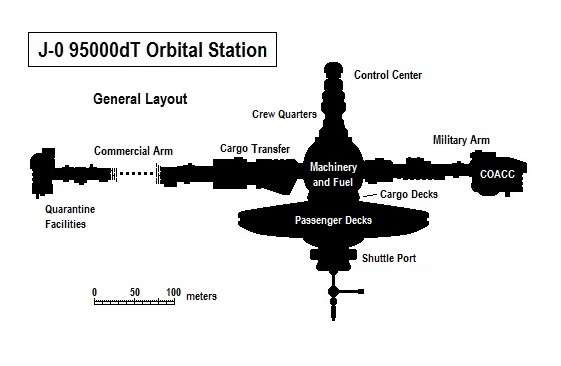Harbor class Orbital Station
| Harbor class Orbital Station | |
|---|---|
 Distant Fringe vessel | |
| Type: AW Station | |
| Category | BCS |
| Size | 95,000 Tons |
| Hull Configuration | Close Structure Hull |
| Streamlining | Partly Streamlined Hull |
| Tech Level | TL–11 |
| Engineering | |
| Computer | Model/5 |
| Jump | J-0 |
| Maneuver | 1 G |
| Armaments | |
| Hardpoints | 950 |
| Accommodations | |
| Staterooms | 4,500 |
| Low Berths | 5,000 |
| Personnel | |
| Crew | 727 |
| Enlisted | 581 |
| High/Mid Passengers | 2,000 |
| Low Passengers | 5,000 |
| Payload | |
| Cargo | 25,000 Tons |
| Fuel tank | 15,950 Tons |
| Construction | |
| Origin | Distant Fringe |
| Price | |
| Cost | MCr24,048.760 |
| Statistics | |
| Universal Ship Profile | AW–Q40X152–490000–80008-0 |
| Images | |
| Blueprint | Yes |
| Illustration | Yes |
| Source | |
| Canon | Unpublished, fan design |
| Designer | Ade Stewart |
| Design System | High Guard |
| Era | 1105 |
| Reference | Fan: Ade Stewart |
The Harbor class Orbital Station is a TL–11 Space Station.
- Please also see AAB article: Ships of the Distant Fringe.
Description
The Orbital Station is a large commercial orbital port facility found within systems in the Distant Fringe region. It is classified as an Orbital City. Similar designs have been in use from the time the Distant Fringe was first settled. They are often associated with Gunsan class Orbital Dockyards.
Image Repository
- A Harbor class Orbital Station with an Olympian class Cruise Liner (silhouetted) alongside.

- Approaching a Harbor class Orbital Station.

General Description
The station is constructed as a close structure. It has four major elements - a flattened sphere-shaped primary hull containing the passenger facilities, a tall spire, a long commercial berthing arm, and a shorter military berthing arm. The primary hull has a height of 40 meters, a diameter of 220 meters, and contains 10 decks of varying height. The spire has a height of 150 meters and contains 45 decks. The military arm has a length of 180 meters and terminates in a COACC installation. The commercial arm has a length of around 450 meters and terminates in isolation and quarantine facilities. Some sections of the station are narrower and some are wider, giving it a total enclosed volume of approximately 1,280,000 cubic meters.
The main fuel tanks and the heavy machinery are located at the base of the spire and the main control center forms its peak. The main cargo holds are located below the fuel tanks, forming the upper decks of the primary hull, and include the cryogenic (low berth) sections. General crew quarters are located within the central section of the spire, though Stewards have rooms close to passenger accommodations.
Middle passage accommodations are found in the less desirable inner zones of the primary hull while first class cabins are traditionally located on its edge, often with windows offering spectacular views. The main commercial strip and leisure facilities are located in the primary hull's core zones and are focused on a multi-deck open plaza. The commercial shuttle port lies at the base of the primary hull and below that is a secondary control room.
The arms are immensely strong and are fitted with multiple docking points, an internal walkway, and external transportation pods.

A basic plan of the station indicating the general layout and positioning of major elements.
Basic Ship Characteristics
Following the Imperial Navy and IISS Universal Ship Profile and data, additional information is presented in the format shown here. The small craft factor indicates the number of squadrons (of ten craft) carried on the ship. Tonnage on the universal ship profile is shown in kilotons (thousands of tons) where necessary. [1]
| Basic Ship Characteristics [2] | ||
|---|---|---|
| No. | Category | Remarks |
| 1. | Tonnage | The Orbital Station is constructed using a 95,000 dTon hull built in a close structure configuration. The hull is partially streamlined but does not have the structural strength to survive entry into a planetary atmosphere.
|
| 2. | Crew | Total Crew Complement: 727
Accommodations:
There are x5000 Low Berths. The low berths are overseen by the station's medical staff, assisted by properly trained service crew. These are most commonly used to store bulk livestock but they may also be utilized by individuals wishing to wait out a period of time (most commonly for financial or tax reasons), or by those seeking medical procedures that may require the arrival of a specialist. It is rare that the station's low berths are fully occupied. Accessible areas of the hull are fitted with grav plates and inertial compensators and have full life support and environmental systems.
|
| 3. | Performance | The station mounts a Maneuver half-drive, and a Power Plant-1, giving performance of 0.5-G acceleration (sufficient for orbital positioning only) and producing 950 Energy Points. The station does not have an agility rating. The dedicated internal fuel tankage gives the power plant 4 weeks duration.
|
| 4. | Electronics | Adjacent to the bridge is a Model/5 Computer: the station has x3 backup Model/5 Computers.
|
| 5. | Hardpoints | x950 hardpoints.
|
| 6. | Armament | The normal weapons fit-out for an Orbital Station is:
x25 100-Ton bays, mounting Heavy Missile Launchers.
x300 triple Beam Laser turrets, forming thirty batteries each of 10 linked turrets |
| 7. | Defenses | The hull is heavily plated and structurally reinforced, giving it an armor rating of 4.
x400 triple Sandcaster turrets, forming fourty batteries each of 10 linked turrets The station is not fitted with screens or other passive defensive systems. |
| 8. | Craft | The station is not supplied with intrinsic subcraft: these are purchased as required by the station's operators.
Hangars |
| 9. | Fuel Treatment | The station has internal fuel tankage of 15,850 dTons.
|
| 10. | Cost | The basic cost of the station is MCr31,025.
|
| 11. | Construction Time | 206 weeks (52 months) as standard.
|
| 12. | Comments | Standard cargo capacity amounts to 25,000 dTons.
|
History & Background (Dossier)
Harbor class Orbital Stations are rugged and known for their excellent safety record. Many are finished to very high standards, offering services and facilities equivalent to surface hotels, leisure complexes and shopping malls, but with the additional benefit that they are free of any local taxes and surcharges. The design is representative and a large number of variants exist, particularly with regard to the allotted weapons systems, onboard electronics, and the fit out of internal spaces.
Support Craft
The station relies on a variety of support craft.
Interface Craft:
Tankers:
Class Naming Practice/s & Peculiarities
A number of companies manufacture facilities equivalent to the Harbor class Station.
They vary in hull shape and internal layout but all share the same basic design and all have very similar capabilities and performance characteristics. Each variant class of station is named by the company that produces it: these organizations generally draw on traditional naming protocols. It is not uncommon for a historical class name to be reused.
Selected Variant Types & Classes
4 Representative Station (AW) Classes
References
| This article has metadata. |

|
This ship was originally designed using one of the Classic Traveller ship design rules:
|
- Author: Lord (Marquis) and Master Scout Emeritus Adie Alegoric Stewart of the IISS
- ↑ Timothy B. Brown. Fighting Ships (Game Designers Workshop, 1981), 10.
- ↑ Timothy B. Brown. Fighting Ships (Game Designers Workshop, 1981), 10.